Amaretto Wheat Variety 10.5% from Felin Ganol Watermill

After writing my last post on Low Protein Flours Make Great Bread, It’s All About the Flour I said I would write in detail how I made my loaves using Anne Parry’s Amaretto white flour from her watermill in Wales. A flour currently being sold as All Purpose because of its low protein content, 10.5%. As you can see I made good loaves out of it, this flour was a hit, has great flavour. I was only able to make two loaves since I had just 1 kilo of it. I’ve ordered some more and can’t wait to experiment further with it.
I find this type of flour doesn’t like to be over-worked. If you use Dan Lepard’s folding method then this flour is very easy to handle. I used my standard recipe to try out my first loaf, holding back a little of the water and seeing how it performed in order to push the second loaf further. A good rule for me is to under-everything; under-water it, under-handle it, under-prove it. Then cross your fingers when it goes in the oven.
I saw what Roland produced with his stoneground ancient grains, and it was a lovely light, moist crumb. Roland uses a small amount of added yeast to his dough, apparently in France you’re allowed to add yeast to Pain Au Levain. I wanted to see how far I could go with the Amaretto using only levain.
Stoneground flours even the white versions can have a reputation of being “wholesome” or even “worthiness” and I dislike those words associated with bread. For me, bread should taste good and have a great mouthfeel first, then if you can add other attributes to it that’s ok. The first loaf was good but still a little too dense for my liking, by the second I was extremely happy with the results, exactly what I was hopping for, a lighter aerated crumb.
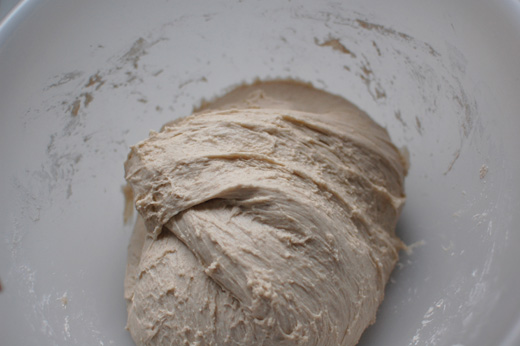
Young Levain – Power & Tasting the Flour
Paul Merry introduced me to the idea of the 2hr levain, which I use frequently for all sorts of reasons and one of them is here. Young levain will have a larger ratio of wild yeast to lactic acid bacteria, read all about it in my post here. This means you’ll have a mild sourdough taste but a powerful levain. I wanted to make sure this dough had the best chance to rise well. And it did.
The other reason to use a young levain with a milder acidic ratio is to taste the flour better. Lactic acid bacteria are amazing and they provide sourdough with wonderful depth of flavour. This is extremely welcomed with lean roller mill white flours, but I’ve learnt when wanting to taste a flour I have to bring down the acid in the levain, allowing the flavour of the flour to come through more…or not…as the case maybe.
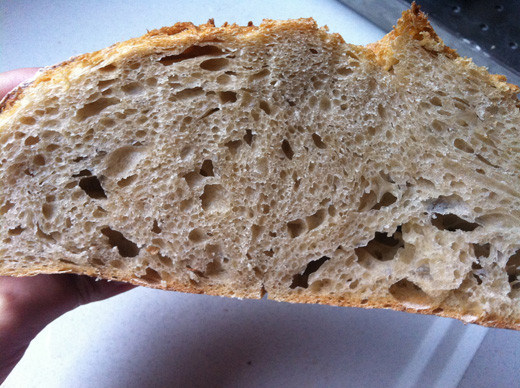
Crumb from second loaf
Stiffer Levain
The other thing you can do which will also bring a powerful levain into the dough is a stiffer levain. I make a liquid levain; doubling the water and doubling the flour to the amount of starter. This is out of habit.
If you remember reading my post on the Cycle of Sourdough Starter Part I where I detail Debra Wink’s great work on Lactic Acid Bacteria, she explains how the progress of a drier starter is slower, everything happens much slower. I also refer to McGee in that post, who explains how cells need water in order to work, therefore the more water the more the process is accelerated.
I saw this in action with Roland’s levain, he uses 2 parts flour for 1 part water. His bread is very mild tasting as far as sourdough goes, in fact not sourdough at all in acidity, but where the flavour is coming from is from his flour. Not only is the acidic levels lower but he had a powerful levain (even accounting for the added yeast).
I’m going to experiment with stiff levains for the heck of it. I expect to leave them longer than my liquid one and still have a powerful boost from the amount of wild yeast remaining. The slower rate of progress fom the lactic acid bacteria means the environment will remain less acidic for longer…which means it will not kill off so many of the wild yeast microbes as quicker. Remember wild yeast can only tolerate so much acid created by the lactic acid bacteria, before it is eventually killed off.

My First Loaf – A Good Start
Above is my first loaf, I under proved it as I’ve mentioned.
When it went in the oven it appeared quite flat and on checking the progress I was worried of producing a disk. But no…it had a late “umph” in the oven and sprung into action in the second half of baking, producing a lovely tear.
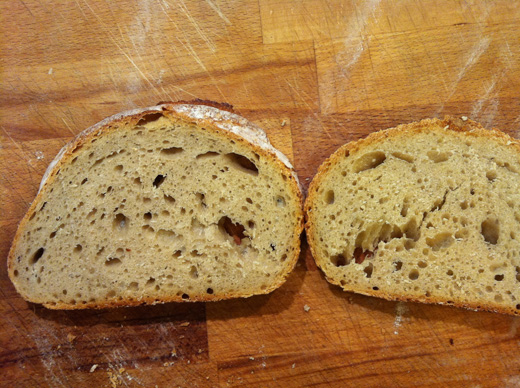
Above is the crumb, good hole distribution but a tad too dense for a “white” flour.
I knew I wasn’t far from getting what I wanted. The flavour was a hit with allergy kid who hates my sourdoughs normally and with Bikerboy who loved it, and asked for more baking with this flour. The crust flavour was absolutely gorgeous.

The Second Loaf – Perfectly How I Wanted
I left it much longer proving on the final prove, about 4 hours on dinning room table, warmish room about 22C, adding a touch more water to the dough…and out came a large beauty. Again a late burst in the oven, just when you think you’re going to end with a duff…there comes out a glorious loaf with all the signs of a good rise.
In both loaves I used a levain only 2-3 hours old, with barely showing any activity.
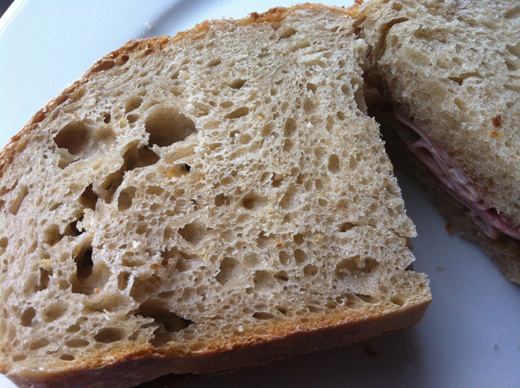
The next day the crumb was still very moist, it’s something I’ve noticed with stoneground white flour…how much more moist the crumb is the next day than that of a white roller mill flour. I’m guessing it’s all the extra bits from the wheatberry.
The crumb on this second loaf turned out exactly how I hoped, full of medium holes surrounded by other little holes, giving you a lighter aerated crumb.
A Step by Step of the Second Loaf
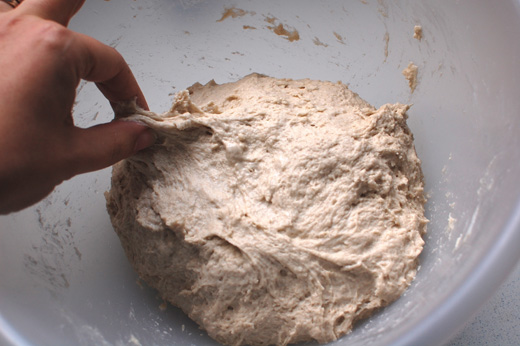
My standard recipe to experiment with all loaves is Dan’s White Sourdough from The Handmade Loaf Book.
For the 500g of flour I think I added about 280g ish of water.
I explained in the Low Protein Flours Make Good Bread post how this dough feels so different to the ones made with white roller mill flour. There’s lack of extensibility. The gluten strands are short and as you pull the dough apart it tears easily, with no stretch.
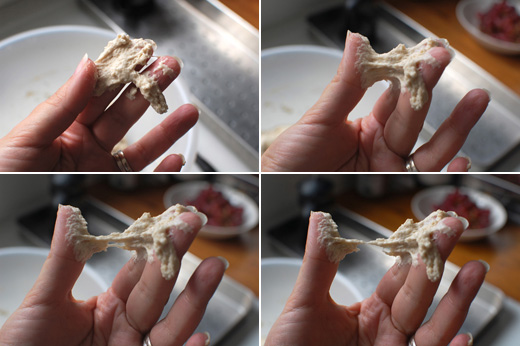
Below is the dough after having its first fold. Left it to rest.

Although it lacks the chewing-gum-like texture in the dough it still has plenty of bounce.
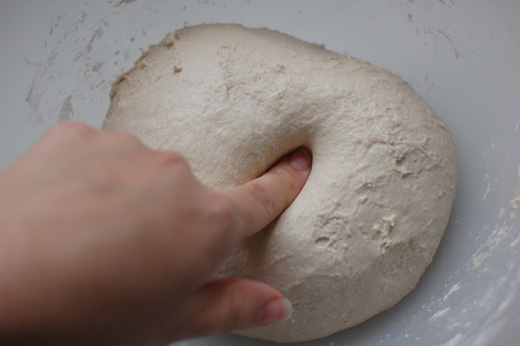
On pressing it firmly it bounces back nicely.
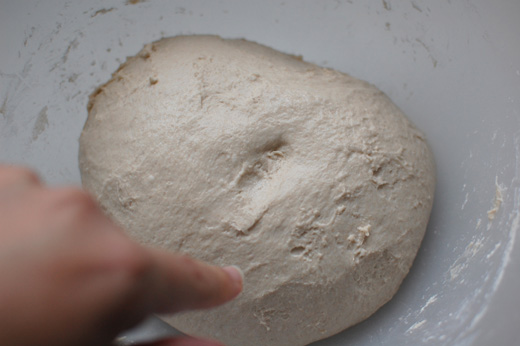
After first folding left it on dinning room table for about 30-45mins, as you can see below, it’s spread out filling the bottom of the bowl, activity is happening.
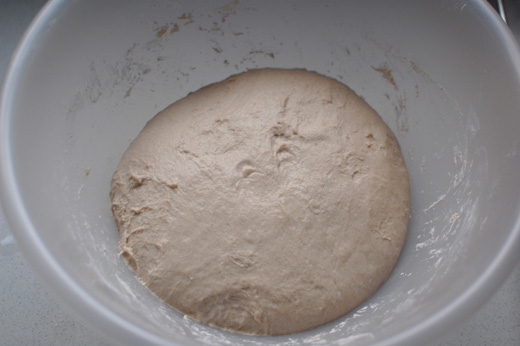
The second folding. I fold my doughs inside the bowl, easier. Using one hand to fold and the other to turn the bowl.

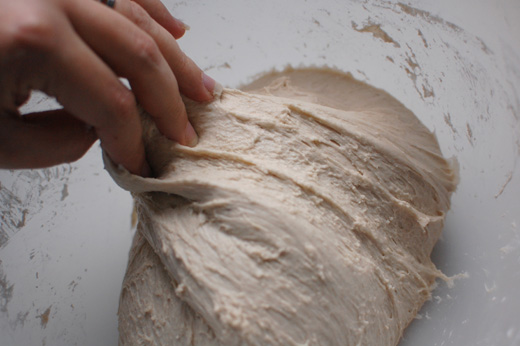
As you pick it it will feel sticky and feel as if breaking apart but it doesn’t.
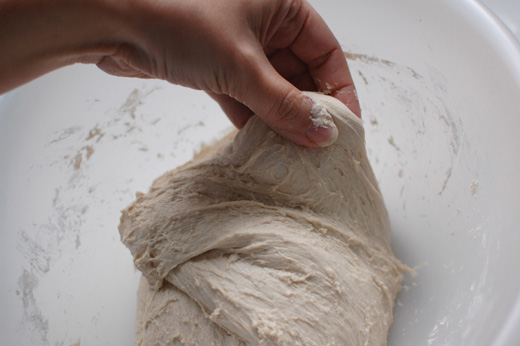
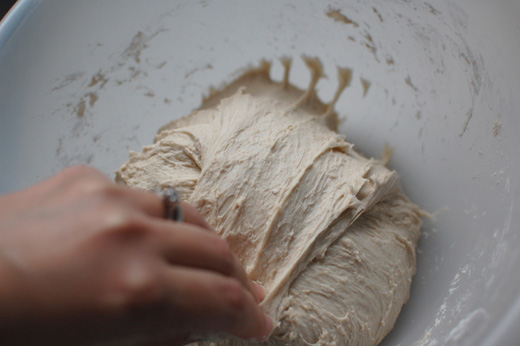
Keep on folding it until you’ve gone around the bowl 2 or 3 times and it’s been nicely stretched.

Turn it over, cover it again and leave it to rest.

Another 30-45mins later you’re ready to shape it and place it in a proving basket/banetton or like I do on top of baking sheet lined with baking paper.
Not wanting to take many chances with this loaf I lifted the paper upwards to stop the dough spreading in case it did too much spreading. Just put anything behind the paper to keep it in place and act as support.
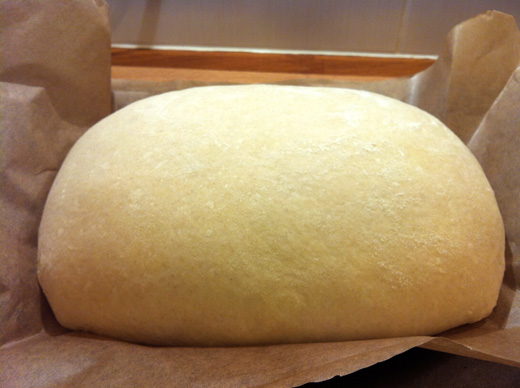
Left it to rise about 4 hrs. Bake it with steam.
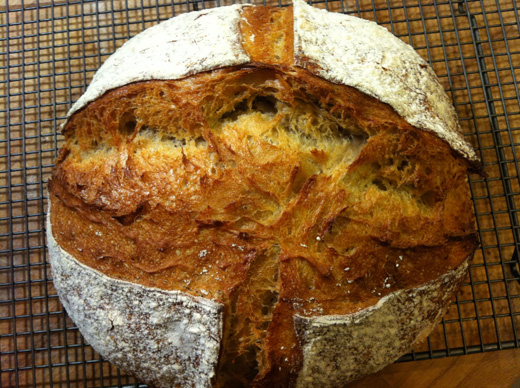
Using Amaretto Wholemeal
The loaf below was using 50% white roller mill flour (Shipton Mill organic no.4 at 12% protein) and 50% Amaretto wholemeal.
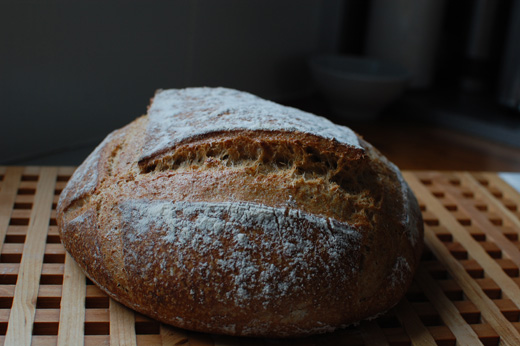
Great flavour, good soft crumb.
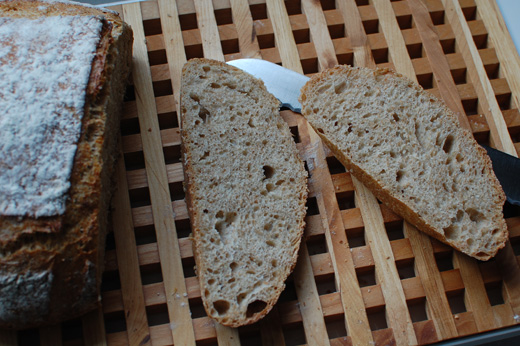
Adding a Touch of Amaretto Wholemeal
The loaf below I added 100g of the wholemeal Amaretto to a normal white roller mill flour (400g) for a client yesterday. I had shaped it and left it to retard overnight in the fridge, baked it during the morning. I had added dried sultanas, cranberry & apricots as per norm. It was extremely well received, apparently most of the loaf had vanished during the afternoon.
I had made a second one for a friend but instead of giving it I ate it…well…I was curious to taste what difference a bit of wholemeal Amaretto would make. OK, I didn’t eat it by myself, I used if for sandwiches for all of us. It was very popular, father-in-law commented how lovely the crust was.
The crust was really quite gorgeous, it had an amazing crunch and this beautiful sweetness from the wholewheat. I think retarding overnight brought all those natural sugars out, which is always accentuated in the baking of the crust.

And so I had to bake another loaf for the friend…which I did.
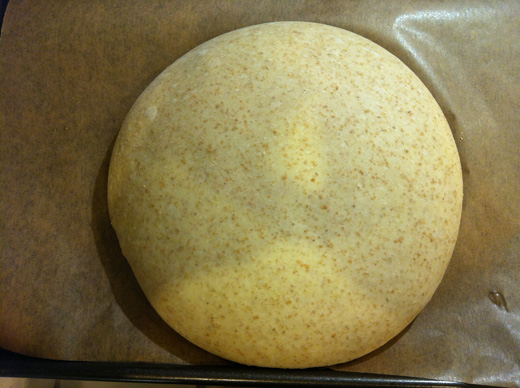
You can see on last proving the outside skin wanting to tear. I used a little too much water in this dough than normal, by about 30grms, and then didn’t support while final proving it, causing it to tear.

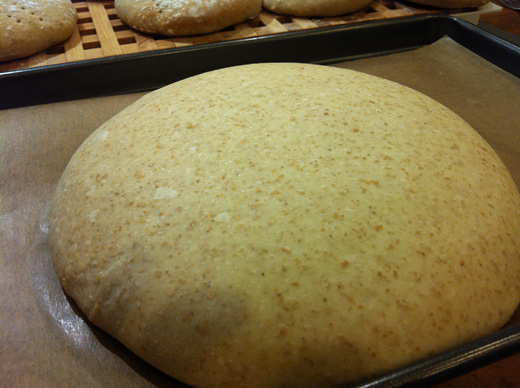
But it still did its thing nicely…and the friend was very happy indeed.
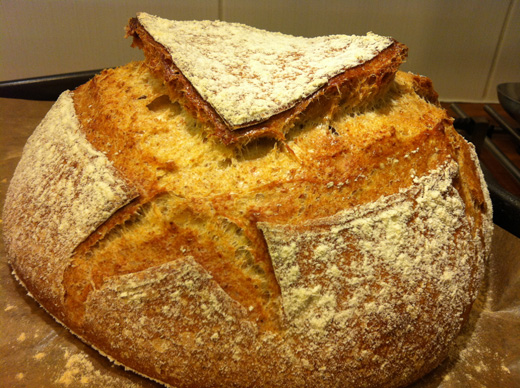
Anne & Andrew Parry & Felin Ganol Watermill
I must tell you how I love Anne & Andrew’s story. One of the fantastic things about my baking journey has been coming across great people involved in the world of baking like Anne.
Anne together with her husband bought a house with a broken down mill. They loved the garden but never gave much thought to the broken mill until after buying the property. Neither of them had any experience in milling, Anne was a plant pathologist and Andrew a computer network manager at Aberystwyth University, but their curiosity got the best of them and thought, “…wouldn’t it be nice if we could make the mill work again?”
They did put the mill back together again, and since June 2009 they’ve been selling small batches of flour. The white flour I used here is a recent addition from this summer (why it’s not even up on their site yet).
The Amaretto is grown by an organic farmer in Harpenden called Howard Roberts. Anne & Andrew also mill a grain which the Aberystwyth University agreed to test out for them, a spring wheat called Tybalt, you can read more about it here, on the university’s site.
Talking to Anne it quickly became apparent how she’s fallen in love with this ancient way of milling. She said they’ve had a huge learning curve and have enjoyed the process of it. Anne says their plans are to stay small and to keep on experimenting with interesting varieties, it’s the resulting flavour of the flour they produce which drives them to want to mill some more.
If you want to get hold of some Amaretto, or the other flours, Anne’s site is here. E-mail her asking about the white Amaretto.
Other Source of Amaretto Flour
Another source of getting hold of Amaretto is through Bakery Bits website I discovered. Patrick or his brother have always been really good when I’ve dealt with them on other things.
Patrick told me last week he has Amaretto flour from Foster’s mill here. Patrick says last year’s Amaretto milled there has added foreign flour because it only came up to 10.4% protein. As I’ve explained in last post and here, this is usually not considered to be good enough for bread but I’ve shown it can indeed produce good loaves.
It seems this year’s crop being milled now is pure 100% Amaretto…yay! If getting Amaretto through Bakery Bits contact Patrick and make sure he sends you the 100% Amaretto, he’ll be only too happy to help.
